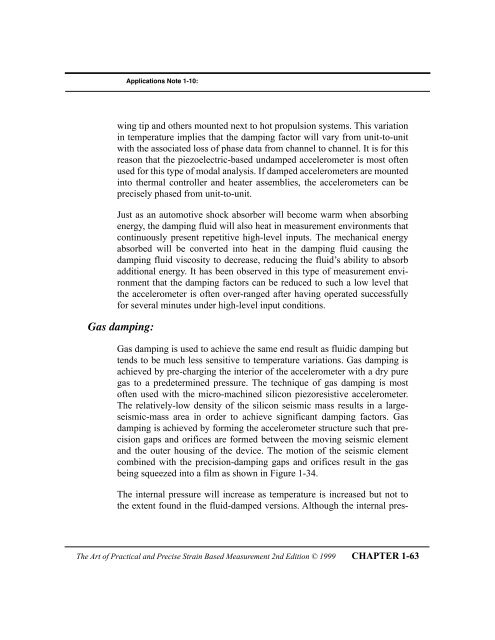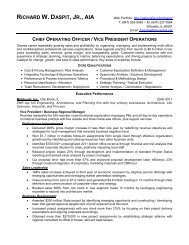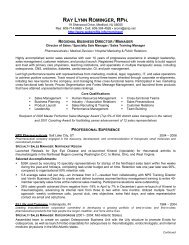The Art of Practical and Precise Strain Based ... - Webprofile.info
The Art of Practical and Precise Strain Based ... - Webprofile.info
The Art of Practical and Precise Strain Based ... - Webprofile.info
- No tags were found...
You also want an ePaper? Increase the reach of your titles
YUMPU automatically turns print PDFs into web optimized ePapers that Google loves.
Applications Note 1-10:wing tip <strong>and</strong> others mounted next to hot propulsion systems. This variationin temperature implies that the damping factor will vary from unit-to-unitwith the associated loss <strong>of</strong> phase data from channel to channel. It is for thisreason that the piezoelectric-based undamped accelerometer is most <strong>of</strong>tenused for this type <strong>of</strong> modal analysis. If damped accelerometers are mountedinto thermal controller <strong>and</strong> heater assemblies, the accelerometers can beprecisely phased from unit-to-unit.Just as an automotive shock absorber will become warm when absorbingenergy, the damping fluid will also heat in measurement environments thatcontinuously present repetitive high-level inputs. <strong>The</strong> mechanical energyabsorbed will be converted into heat in the damping fluid causing thedamping fluid viscosity to decrease, reducing the fluidÕs ability to absorbadditional energy. It has been observed in this type <strong>of</strong> measurement environmentthat the damping factors can be reduced to such a low level thatthe accelerometer is <strong>of</strong>ten over-ranged after having operated successfullyfor several minutes under high-level input conditions.Gas damping:Gas damping is used to achieve the same end result as fluidic damping buttends to be much less sensitive to temperature variations. Gas damping isachieved by pre-charging the interior <strong>of</strong> the accelerometer with a dry puregas to a predetermined pressure. <strong>The</strong> technique <strong>of</strong> gas damping is most<strong>of</strong>ten used with the micro-machined silicon piezoresistive accelerometer.<strong>The</strong> relatively-low density <strong>of</strong> the silicon seismic mass results in a largeseismic-massarea in order to achieve significant damping factors. Gasdamping is achieved by forming the accelerometer structure such that precisiongaps <strong>and</strong> orifices are formed between the moving seismic element<strong>and</strong> the outer housing <strong>of</strong> the device. <strong>The</strong> motion <strong>of</strong> the seismic elementcombined with the precision-damping gaps <strong>and</strong> orifices result in the gasbeing squeezed into a film as shown in Figure 1-34.<strong>The</strong> internal pressure will increase as temperature is increased but not tothe extent found in the fluid-damped versions. Although the internal pres-<strong>The</strong> <strong>Art</strong> <strong>of</strong> <strong>Practical</strong> <strong>and</strong> <strong>Precise</strong> <strong>Strain</strong> <strong>Based</strong> Measurement 2nd Edition © 1999 CHAPTER 1-63
















